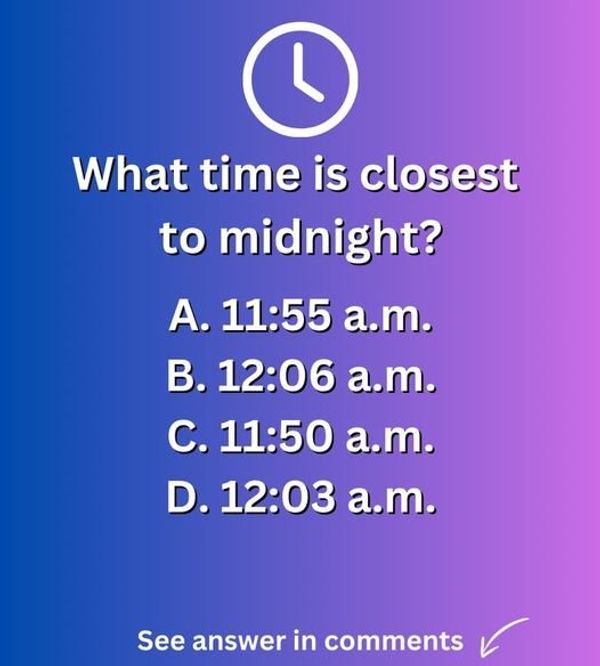What started as a seemingly childish math question on a popular social network quickly grew into an international viral sensation, sparking intense debates among adults. The question, which was initially posted on Reddit, asked for “the time closest to midnight.” However, it soon became apparent that behind this apparent simplicity lay a complex problem. Thousands of comments flooded in, showcasing not only people’s math skills but also their critical thinking abilities.

The Unexpected Question
In June 2023, a Reddit user named @yawdmontweet from Jamaica posted a thought-provoking question: “What is the time closest to midnight?” The options provided were: A. 11:55, B. 12:06, C. 11:50, D. 12:03. Despite its directness, this question captured the attention of users worldwide, causing the post to go viral in no time.
Unraveling the Complexity
Soon, this math puzzle became the talk of forums, classrooms, and casual conversations. People from all walks of life were eager to unravel the complexity hidden behind these simple time options. The heart of the extensive online discussion revolved around the interpretation of “closest to midnight.” While the majority supported option D (12:03), the subtlety of the question resulted in a wide range of responses.
Contrary to what one would expect from a math question, this puzzle involved not only calculating time intervals but also exploring the semantic nuances of the question itself. It became clear that language and context played a fundamental role in our perception and approach to seemingly simple problems.
The Power of Interpretation
The viral math puzzle showcased the richness of human interpretation when faced with an apparently straightforward question. Some users approached the question based on the physical proximity of the time to midnight, leading to answers closer to noon. Others took a more abstract perspective, delving into concepts like “the run-up to midnight” and even philosophical questions of time and space.
These diverse approaches revealed a fundamental question: How does our perception of words and context influence our understanding of a problem?
The Role of Artificial Intelligence
Artificial intelligence, specifically tools like ChatGPT, also played a significant and controversial role in the discussion. Some participants turned to AI to provide a scientific perspective on the puzzle. However, while ChatGPT concluded that option D (12:03 a.m.) was the time closest to midnight, others argued that relying solely on AI’s interpretation might be too narrow for a question that requires a more flexible consideration of context.
Implications for Education
The extensive debate surrounding this math puzzle raises an important concern for education. The fact that a seemingly straightforward question can yield multiple valid answers depending on interpretation calls for clarity in the formulation of educational materials. This is especially crucial in subjects like mathematics, where confusion at a young age can lead to frustration and a lasting aversion to the subject.
In Conclusion
This viral math puzzle demonstrates how a question at the intersection of language and logic can become a global discussion point. It provides valuable insights into the complexity of human cognition, showcasing how different people interpret information and approach problems. It reminds us that even the simplest questions can lead to profound intellectual challenges and cultural connections.





